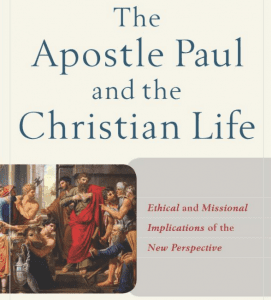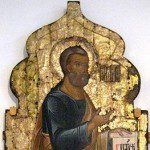 We all walk around with models, ideas, configurations, or theologies in our mind. When we encounter something or someone or a new idea or an old idea or a strange idea, what is in our mind both influences what we hear and permits us to interpret what we encounter. In that sense, Paul, too, was a theologian. But in the history of Christianity some very specific configurations have taken shape — systematic theologies as we see in folks like John Calvin, Charles Hodge, Karl Barth, or Robert Jenson — and Paul did not write that kind of systematic theology. He did not sit down an pull it all into one theological writing but instead responded to specific situations (e.g., Colossians) on the basis of what was in his mind. But the construction of the latter from the former is reconstructive and (frankly) speculative. Yes, in one sense we are seeking to come to terms with what Paul believed but Paul did not leave us a single writing that does that.
We all walk around with models, ideas, configurations, or theologies in our mind. When we encounter something or someone or a new idea or an old idea or a strange idea, what is in our mind both influences what we hear and permits us to interpret what we encounter. In that sense, Paul, too, was a theologian. But in the history of Christianity some very specific configurations have taken shape — systematic theologies as we see in folks like John Calvin, Charles Hodge, Karl Barth, or Robert Jenson — and Paul did not write that kind of systematic theology. He did not sit down an pull it all into one theological writing but instead responded to specific situations (e.g., Colossians) on the basis of what was in his mind. But the construction of the latter from the former is reconstructive and (frankly) speculative. Yes, in one sense we are seeking to come to terms with what Paul believed but Paul did not leave us a single writing that does that.
Hence, we turn to Timothy Gombis’ new essay “Participation in the New-Creation People of God in Christ by the Spirit,” in the book Joe Modica and I co-edited, The Apostle Paul and the Christian Life. One of the biggest challenges in teaching the NT is to get folks to read Paul in light of what he actually says and to bracket out the larger synthesis of systematic theology that many of us believe. That systematics, in fact, can prevent us from putting the Bible together the way it is put together: a narrative that is filled out over time rather than a timeless presentation of ideas.
No discussion of habits that create the virtuous character in Paul; rather, an ecclesial fellowship into which we are baptized by the Spirit, by grace, for the sake of forming a new fellowship that demonstrates God’s rule in this world.
Gombis opens with a #boom claim:
The revolution in Pauline studies over the last four decades initially challenged and now has broken the dominance of a singularly Protestant reading of Paul focused on justification by faith. ….Without necessarily downplaying the importance of justification, it now seems plain that it is one among a number of images and metaphors for configuring the character of Christian identity (103).
And here, too, Gombis clarifies what is distinctive (not the same as unique) to the new perspective:
The focus of Paul’s reflection on the Christian life is the church, the new-creation people of God made up of individuals-in-community. Paul does not conceive of individuals living the Christian life in isolation from the community. Because these communities derive their identities (their history, language, mission, symbols, patterns of relating, and social dynamics) from the biblical storyline, I will situate the Christian life within the narrative of Scripture, stretching from creation to new creation, touching down in Israel and determined ultimately by the faithful life of Jesus (104).
Then Tim sketches the Bible’s narrative about humans: made to rule for God but who have chosen to worship creation rather than the Creator. Thus,
First, humanity, created in God’s image and called to rule creation on God’s behalf, failed to do this. Humans have turned against God and against one another, becoming idolatrous, so that God does not inhabit creation as his temple according to his original intentions. Second, God has called one man, Abraham, to become the agent of God’s reclamation of all humanity. Third, Abraham’s “seed,” the nation of Israel, called by God to lead the nations back to Israel’s God, who is also the Creator, has also failed, turning against one another, against the nations, and against God, and has become idolatrous. God had intended to dwell with Israel in anticipation of fulfilling his original intention of dwelling with all humanity as his temple (108).
Hence, the narrative of the Bible is in search of a concluding chapter, in search of salvation, something that resolves the problem of idolatry by being obedience, or make that someone:
Jesus is the true human who renders to the creator God a faithful obedience embodied by a life of self-giving love for others. Jesus Christ, then, and his relation to the entire range of God’s redemptive purposes, becomes the context within which the Christian life takes place and the template for what it involves (109).
- First, Jesus redeems the failed narrative of Adam and Eve.
- Second, Jesus is the true seed of Abraham, making good God’s promises to the patriarch.
- Third, and related to the second point, Jesus is the true Israelite who fulfills Israel’s mission to be a light to the nations, unleashing God’s blessing on all humanity and drawing the nations into the praise of the God of Israel.
- Fourth, Jesus’s life of faithfulness to God and love for others sets the template for the Christian life.
- Fifth, the presence of Jesus fills each church community by the Spirit of Jesus.
Notice the christological focus here, rather than justification theory or atonement theology, the resolution is a Person named Jesus. God is creating in Jesus — through the Spirit — a new creation community for the sake of the world.
For it is in the church that God’s purposes in calling Abraham and Israel are being fulfilled. In the church of Jesus Christ, God is creating a new body—the body of Messiah Jesus—made up of faithful Israelites and faithful non-Israelites.
First, the Spirit is the eschatological presence of God that had been promised by the prophets—the very presence of God’s life-giving Spirit poured out on God’s people in the coming age.
Second, churches baptized into Christ by the Spirit have their existence ‘in Christ.” The union of church communities with God is so intimate that the corporate life of church communities is said to take place within God, within Christ (Col. 3:3; Gal. 2:20).
Third, because the Spirit intimately unites believers to Christ, believers are vitally connected to the church and to one another. Paul uses the metaphor of “the body of Christ” in several places (Rom. 7:4; 12:5; 1 Cor. 10:16; 12:12) with a variety of meanings.
… For Paul, then, the baptism of believers into Christ means that they have their very existence in God and that they are vitally connected to one another.
Hence, the Christian life is about participation in the new-creation people of God and participation in God through Christ by the Spirit. Thus, the themes are members of the Body, cruciformity and unity as well as our being the temple and empowered by the Spirit to be that new creation people of God.












